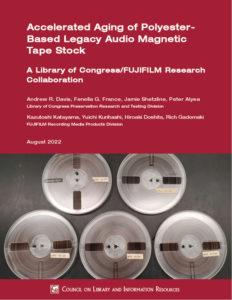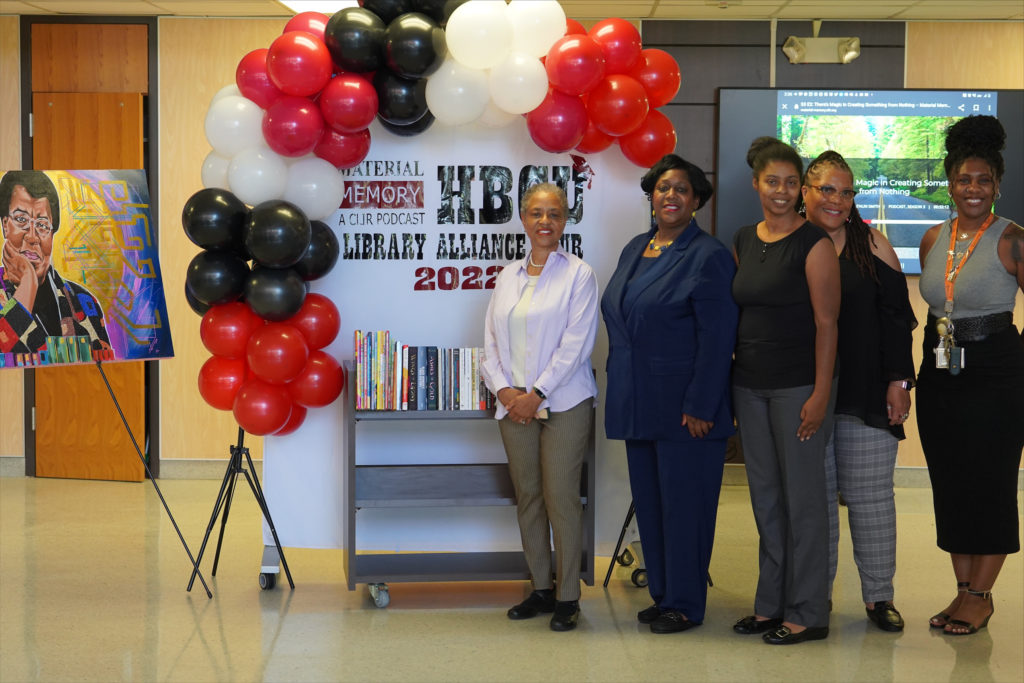A new study published by CLIR suggests that a type of audio tape commonly used since the 1950s may have greater longevity than previously thought. Researchers from the Library of Congress’s Preservation Research and Testing Division and FUJIFILM Recording Media Products Division did a variety of tests on specific models of open-reel polyester tape produced 10 to 20 years ago. They concluded that the tapes in their research sample that are playable today and are kept at standard room conditions are likely to be playable for as long as 100 years into the future. The findings, presented in Accelerated Aging of Polyester-Based Legacy Audio Magnetic Tape Stock, could have significant implications for preservation planning of audiovisual collections, as they more than double the predicted life expectancy of some types of magnetic tapes.
 Commercial polyester tapes were introduced in the 1950s and quickly gained widespread acceptance and use. While the polyester film itself is quite stable over time, the binders used in the magnetic layers of these tapes are susceptible to degradation. Some formulations are known to be widely problematic and have rendered tapes unplayable within decades. However, there remains uncertainty about the stability of currently playable historical magnetic tape recordings. The study addresses that question, which can be pressing for institutions that have large collections of seemingly good magnetic tapes.
Commercial polyester tapes were introduced in the 1950s and quickly gained widespread acceptance and use. While the polyester film itself is quite stable over time, the binders used in the magnetic layers of these tapes are susceptible to degradation. Some formulations are known to be widely problematic and have rendered tapes unplayable within decades. However, there remains uncertainty about the stability of currently playable historical magnetic tape recordings. The study addresses that question, which can be pressing for institutions that have large collections of seemingly good magnetic tapes.
The study focused on two main areas. First, test tapes were subjected to a variety of accelerated temperature and relative humidity ranges, chosen to best predict and assess potential conditions for storage in institutions with and without controlled environmental options. Second, changes to the tapes’ physical, magnetic, and chemical properties were measured to assess their impact on the tapes’ usability. The key findings were as follows:
“Based on recommendations published 10 to 30 years prior to the time of this writing, the life expectancy for magnetic tapes was predicted to be 10 to 30 years if institutions adhered to published storage guidelines,” note the authors. “This study of legacy tapes at the upper end of this age range offers an opportunity to re-evaluate those blanket predictions.” The authors note that further research would confirm how broadly their findings apply to other models of tape.
Accelerated Aging of Polyester-Based Legacy Audio Magnetic Tape Stock is available electronically at https://www.clir.org/pubs/reports/accelerated-aging-of-polyester-based-legacy-audio-magnetic-tape-stock/.
A new publication from DLF’s Born-Digital Access Working Group (BDAWG) puts forth a set of guidelines for thinking through the complex legal and ethical issues involved in providing access to born-digital archival records.
Legal and Ethical Considerations for Born-Digital Access brings together research about many common access restrictions and sensitivities found in archival collections, differentiates how these restrictions may show up in born-digital collections, condenses information into a few pages of material on each topic, and describes steps that workers and organizations can take to mitigate risk when providing access.
The report opens with a series of recommendations for all collections. In distinct sections, it then addresses attorney-client privilege, copyright, donor agreement, the Family Educational Rights and Privacy Act, the General Data Protection Regulation, the Health Information Portability and Accountability Act, Indigenous materials in the United States, institutionally mandated confidentiality, personally identifiable information, privacy, terms of service, and finding support.
The publication is the result of a collaborative research effort by BDAWG’s Legal Due Diligence subteam, which was established in 2020 to assess issues around privacy, copyright, and other legal and ethical challenges related to providing access to born-digital archival records. Subteam members include Jessika Drmacich, Williams College; Kate Dundon, University of California Santa Cruz; Jess Farrell and Hannah Wang, Educopia Institute; Christina Velazquez Fidler, Bancroft Library at University of California, Berkeley; and Camille Tyndall Watson, NoveList, a division of EBSCO Information Services.
The group has started a monthly blog series comprising a set of primers that speak to the various legal and ethical issues addressed in the report. In the introductory blog, the authors list the topical areas that will be covered in the series, noting that “Our goal is to promote access to born-digital materials despite all of these barriers, and that starts with talking to your donors, building infrastructure, and adopting thoughtful processing procedures.”
CLIR welcomes our new Community Data Fellows as the eighteenth cohort of the Postdoctoral Fellowship Program. Fellows will work on projects that thoughtfully and ethically capture and share data relevant to historically underrepresented or misrepresented people, communities, and populations. Community data encompasses digital or digitized records of researchers and community members, materials from community archives, information captured from the web and social media, and records of individuals or organizations. Projects will focus on collecting, aggregating, describing, preserving, and using these data.
Launched in 2004, CLIR’s Postdoctoral Fellowship Program offers recent Ph.D. graduates the chance to develop research tools, resources, and services while exploring new career opportunities. Fellows work on projects that forge and strengthen connections among collections, educational technologies, and current research. Partner organizations benefit from fellows’ field-specific expertise by gaining insights into their collections’ potential uses and users, scholarly information behaviors, and current teaching and learning practices.
The new fellows and their supervisors will begin the program with an introductory online seminar from August 29 through September 2. The seminar provides an opportunity for them to meet others in their cohort to share experiences and information, become oriented to the program, and establish a solid foundation for the beginning of their fellowships.
Five fellows from the 2020 cohort will spend a second year at their host institutions.
Southern University at New Orleans (SUNO) is the winner of Material Memory podcast’s Battle for the Books Competition, having garnered the most episode downloads in the two weeks following release.
On July 21, HBCU Library Alliance and CLIR Board member Sandra Phoenix and CLIR program officer and podcast host Sharon M. Burney presented a collection of author-signed books on Africana history, cultural and contemporary affairs, and a painting of author Octavia E. Butler by artist Yvonne Ferguson to staff at SUNO’s Leonard S. Washington Memorial Library. They were joined by library employees, representatives from New Orleans Public Library, the College of Arts and Science, the director of the campus museum (SUNOMA), and library science students from Louisiana State University, and undergraduate and graduate students from SUNO.
Material Memory’s third season, HBCU Library Alliance Tour, spotlights people and collections at six Historically Black Colleges and University (HBCU) libraries, and the vital role that these institutions play in their communities. Featured institutions were Alcorn State University, Benedict College, Fisk University, Morgan State University, SUNO, and Tuskegee University.

This fall, CLIR will publish an assessment of the first iteration of the Digitizing Hidden Collections: Amplifying Unheard Voices program.
The assessment was undertaken by Jesse Johnston and Ricardo “Ricky” Punzalan, working closely with former CLIR program officer Joy Banks and senior director of research and assessment Christa Williford. The team’s analysis is based on feedback supplied by applicants, reviewers, recipients, and staff during the first full review cycle for the program. Using this data, the team has formulated recommendations for improving the efficiency, transparency, and alignment of the program to the needs of U.S. and Canadian constituents who work with rare and unique collections with the potential to “deepen public understanding of the histories of people of color and other communities and populations whose work, experiences, and perspectives have been insufficiently recognized or unattended.”
Johnston and Punzalan will be presenting and discussing their findings this fall at conferences and meetings hosted by CLIR (Digitizing Hidden Collections Symposium, “Understanding Audiences” panel, Oct. 13) and the Association of Tribal Libraries, Archives, and Museums (ATALM), (poster session, Oct. 26). Their work will directly inform strategic planning for future grantmaking initiatives at CLIR.
ISSN 1944-7639
Content is not copyrighted and can be freely distributed

Council on Library and Information Resources
1800 Diagonal Road, Suite 600
Alexandria, VA 22314
contact@clir.org
CLIR is an independent, nonprofit organization that forges strategies to enhance research, teaching, and learning environments in collaboration with libraries, cultural institutions, and communities of higher learning.
Unless otherwise indicated, content on this site is available for re-use under CC BY-SA 4.0 License